TinyPilot Voyager KVM Hardware Overview
We are simply going to say this: the hardware is what we received in the fall of 2020. There was a hardware revision before this one, but we waited for the newer revision at the time. Still, this is certainly an area where we think that this solution could use more maturity. For example, there could be clips for cable management, better stacking, better mounting, and etc. The point is, this solution has been evolving so we assume that in the future there will be some updates. Please take this as a point-in-time overview.
The TinyPilot Voyager KVM solution comes in a nice 3D printed case. One can get other kits from TinyPilot, but this solution integrates the HDMI input and a fan which helps reduce cable clutter slightly.
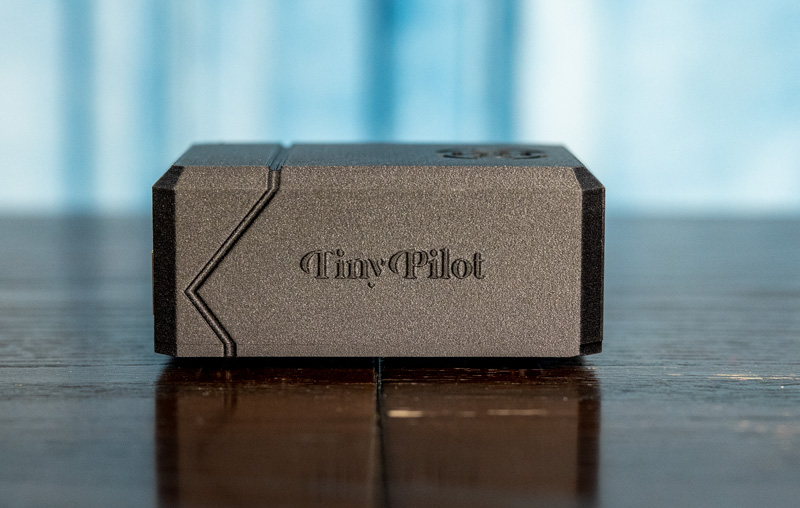
The system itself is built around a 2GB Raspberry Pi 4 so many of the ports and connectors are going to look familiar. What is different is the HDMI input powered by a Toshiba T358743 chip. Adding this extra port above the USB ports is a key driver for the custom 3D printed case.
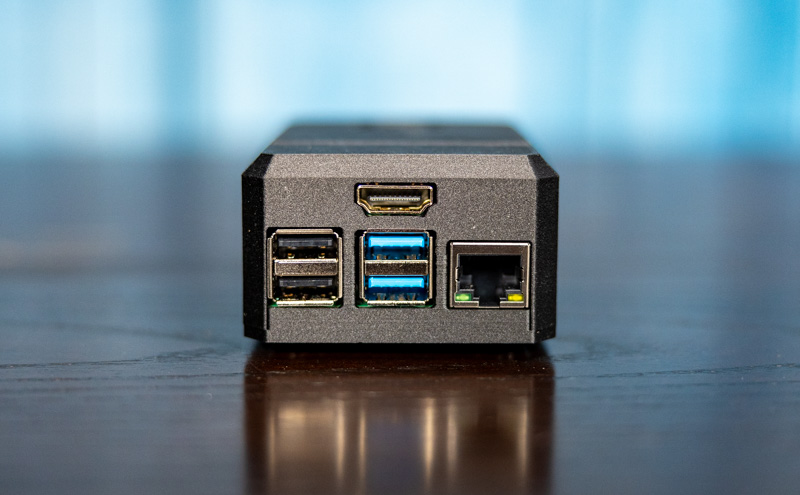
While the Lantronix SecureLinx Spider is really catered more towards traditional servers with VGA input, a key differentiator for the TinyPilot solution is being able to service other types of gear. Specifically workstation gear and development kits that often have HDMI/ DisplayPort outputs.
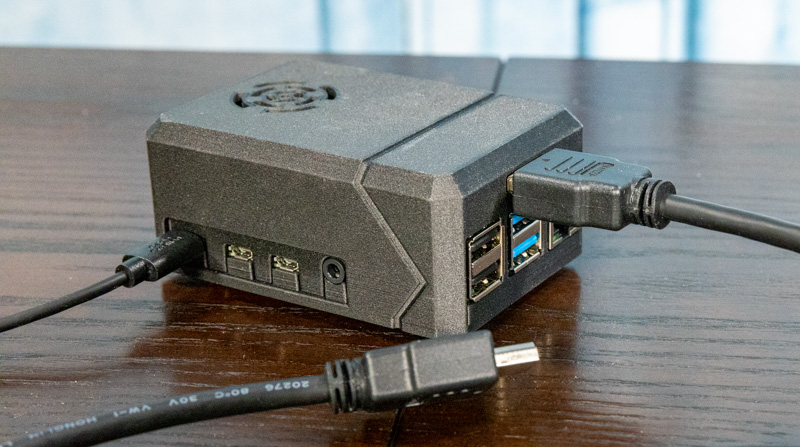
During normal operation, these USB ports are free to service other functions. We have used them, for example, with a FTDI cable to provide serial console control when setting up a Xilinx Kria Edge AI Developer Kit (more on this soon.) We could then transition to the HDMI port as well. This also worked with a NVIDIA Jetson using the HDMI port. Since the Lantronix Spider product has this functionality, we wish that it had a clean option/ interface in TinyPilot, but it is trivial to search how to do this on a Raspberry Pi 4. A major source of strength in the solution is that it has the Raspberry Pi 4 base feature set and documentation.
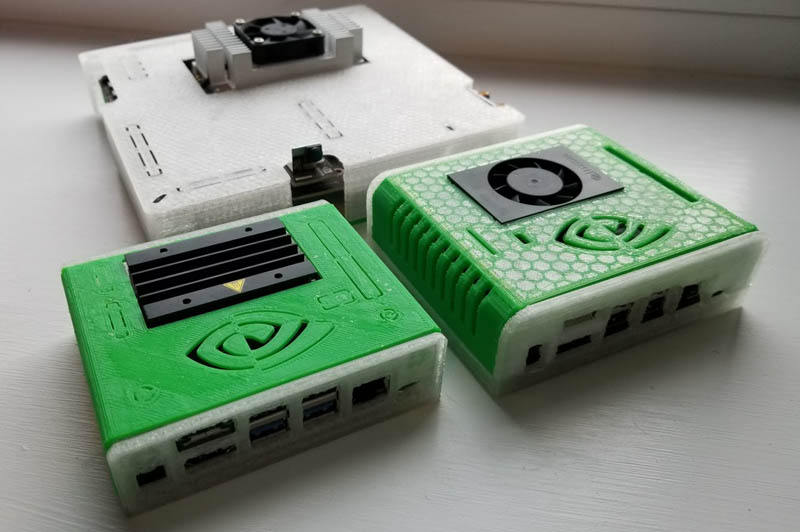
Still, the vast majority of servers still have VGA outputs, and that is why the Lantronix solution is still widely used today. Here is a view of the Supermicro AS-1024US-TRT we recently reviewed where one can see the blue VGA port:

To address this, the TinyPilot Voyager can add a $15 VGA to HDMI converter. This converter requires USB power. We mention that the solution has a lot of wires, and using VGA adds a converter and another wire.
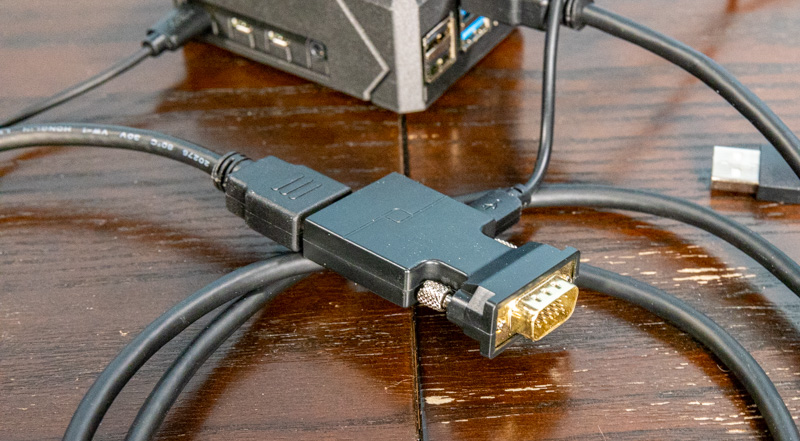
Networking is provided by that 1GbE port for wired networking. Since this is a Raspberry Pi 4, we also get onboard 802.11ac WiFi.
The other side of the unit has the MicroSD card slot. This has the OS image onboard.
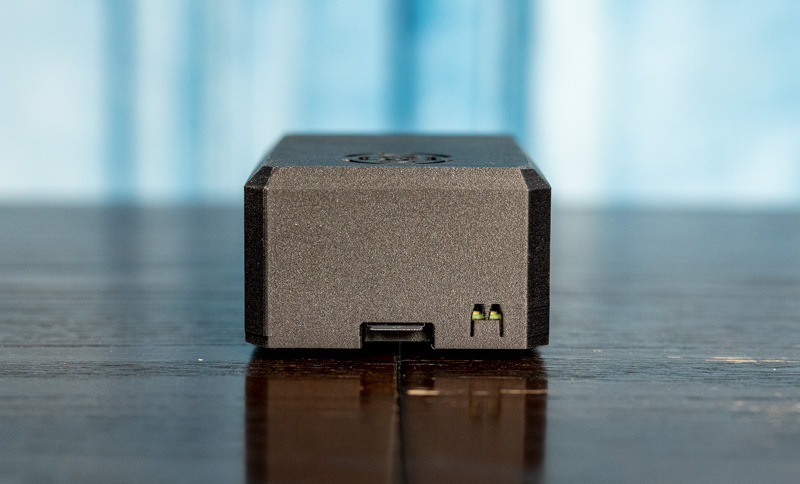
When we did the conversion of the unit to the newest version released a few days ago, we used a different MicroSD card and it worked as expected. Still, for those that perhaps may want more storage for images, having a 16GB card may not be enough these days. It would be nice if the Voyager came with a larger 32GB card just to give more capacity for image storage.
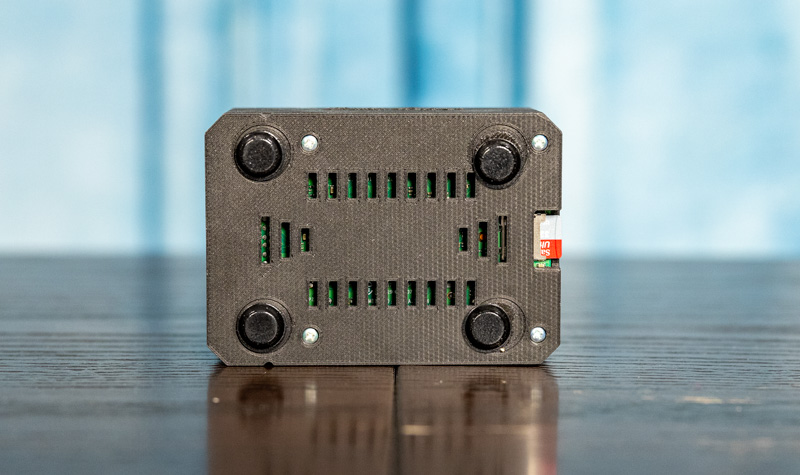
The other side of this chassis is the USB port side, specifically there is one USB Type-C port that is used heavily in this solution.
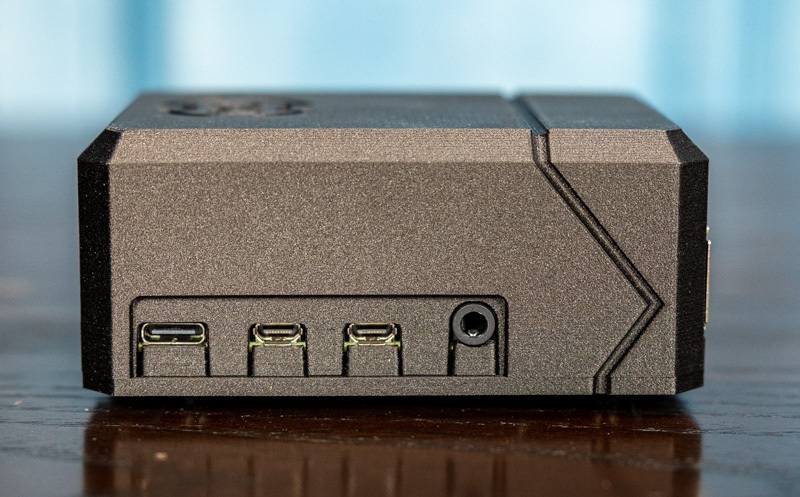
This USB Type-C port provides power input via an included USB power adapter as well as a connection to a power and data box.
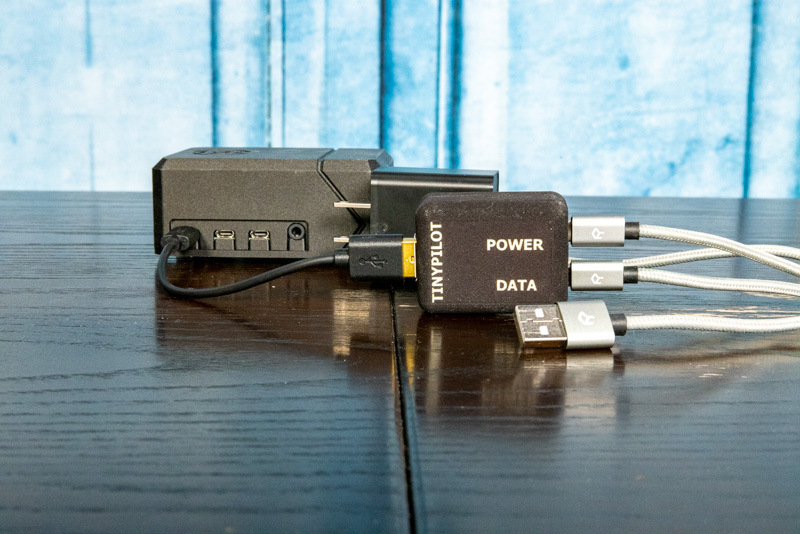
A key challenge with the Lantronix Spider is that while it can be powered via the connected machine’s USB ports, often when a server or workstation is power cycled, power to the Spider is lost and it can take longer for the Spider to boot than the time window lasts to enter BIOS, PXE boot menus, or RAID controller menus. To address this, external power, independent of the attached node is required. That is why the TinyPilot Power Connector exists. It can feed power to the TinyPilot while leaving a separate path for data.

Here is the setup to an Apple Mac Mini M1 using the TinyPilot Voyager and this box.
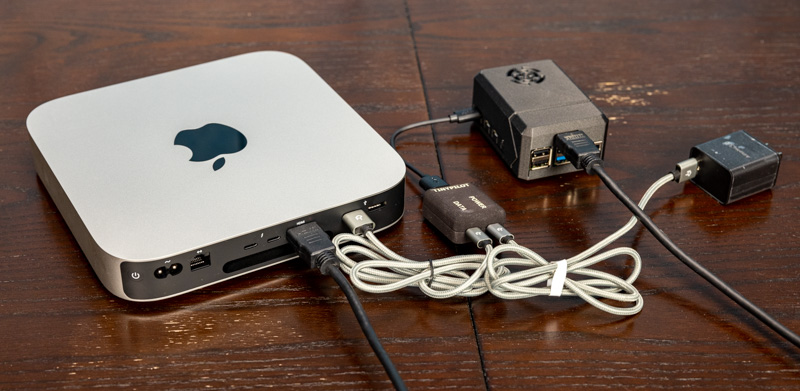
Overall the hardware works well, and the fact that there is a Raspberry Pi 4 inside is a huge benefit for the platform since it makes adding features like serial connections trivial.
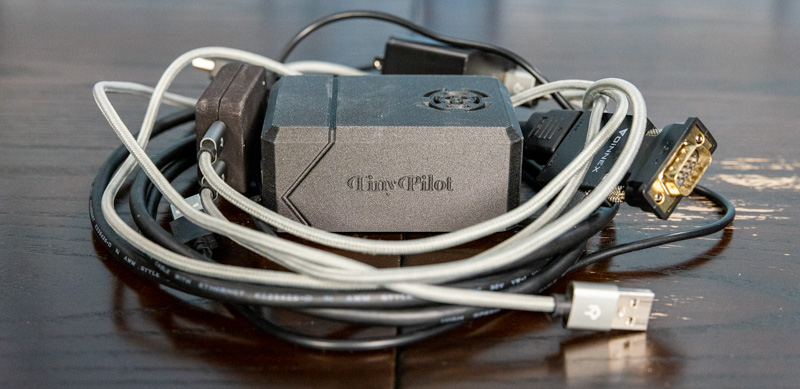
Still, when we prefaced this section by stating that the solution could be destined for hardware upgrades in the future, the picture above that we call the “Cable Nest” (hear a bit more about this near the end of the video), and for good reason. The sheer number of cables and external boxes and adapters required to make this solution work is significant, especially given the HDMI input is brought inside the Voyager’s custom case.
The fact is though, we continue to use this unit all the time with Project TinyMiniMicro and is what we used to setup the Lenovo ThinkCentre M90q Tiny, as an example recently. Having a HDMI input and something that works well with a DisplayPort to HDMI cable as well is extremely useful.
We are aware of the Pi-KVM project, we are still awaiting that project to have a pre-built solution so we can do a similar review.
Still, the hardware is only part of the solution. Software is a big deal. We are going to look at that next.




Too much complicated stuff to substitute a simple serial port.
This is a very interesting solution for IP-based OOB remote management for CoLoc/Start-up/SOHO/Home/DIY for servers or systems without BMC/IPIMI. I did not know about the TinyPilot Voyager. Great review Patrick, you made my Saturday :-) TYVM.
As @domih stated, “I did not know about the TinyPilot Voyager”, I have to say likewise…. 25+ years and I too didn’t realize this was out in the field… Great info and review. As always! Thanks for all your hard work.
A similar project at pikvm org
Indeed. pikvm lacks available hardware, but they’re working on that.
But it also supports connecting up to the ATX header for power/reset.
https://forums.servethehome.com/index.php?threads/pikvm-an-open-source-ip-kvm-project-using-the-raspberry-pi.31004/
Pikvm is in a different class compared to this. It has a mature and well designed code base, no features behind paywalls, and handles all kinds of hardware quirks. It also offers options for power cycling the controlled device, along with vnc support too.
i wondering how do perform power down and reset thought this unit ?! i mean it’s basically function as VNC (without bios part)
@Tony: Read the Website.
Does either project have plans for cellular modem support?
I put my pi in a pic slot with poe and a usb c to internal header, also using pikvm.
Not obviously present in the article, at least to me, though it might be buried somewhere or in a link: What is the cost of this TinyPilot gizmo with the gee-wiz 3D printed case (cuz that is all the rage for NerdZ)?
It was funny to read the Lantronix Spider KVM review by STH where they commented about saving $100 on the Dell iKVM feature via the Dell iDRAC thingie…by spending $280 on the Lantronix Spider. LOL LOL LOL LOL
Sleepy there is pricing as well as a screenshot of current pricing/ offerings just before the Final Words.
Couldn’t they put the data/power splitter inside the case in some way? That would significantly reduce the cable nest.
This could also work in the SMB space where KVM’s may already exist but they are java-based or local only. Replace the local console with tinypilot to modernize old hardware.
I have an inexpensive TRENDnet 8-port VGA/USB KVM switch (TR-803R) that I can switch between the 8 ports using keyboard shortcuts.
Does anyone know if I can hook the monitor/keyboard output of this TRENDnet switch to the TinyPilot Voyager for remote console access to the eight computers connected to the TRENDnet switch?
This project seems to be a less technical version of PiKVM.org
Judging by your thoughts on this product, you should try Pi-KVM out. They are on the verge of releasing dedicated hardware HAT.
Already in-touch with the Pi-KVM folks. Please also remember TinyPilot has been out for 2-3 quarters so this is a review of hardware that has been running for 6+ months while Pi-KVM hardware is still not out (and sounds like it will be in tight supply when it first arrives.)
Noted! I was unaware. I am looking forward to hearing your thoughts on PiKVM, with or without the dedicated HAT.
Only 299$ for a Pi4 (35$) + Extra chip and a custom case ( few dollars at best )… Am i missing something?
Benny I think you’re missing the time to put it together, research the right parts, the power splitter, the adapters, the SD card, the cables and so forth. I don’t think anyone is saying there isn’t margin. I think you’re paying for convenience.